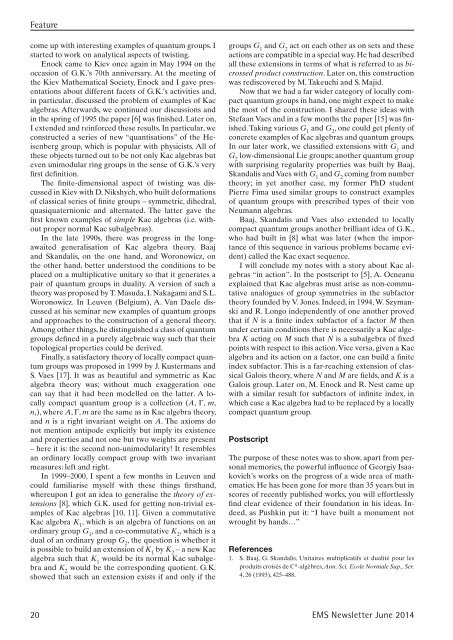1mZ2hsN
1mZ2hsN
1mZ2hsN
Create successful ePaper yourself
Turn your PDF publications into a flip-book with our unique Google optimized e-Paper software.
Featurecome up with interesting examples of quantum groups. Istarted to work on analytical aspects of twisting.Enock came to Kiev once again in May 1994 on theoccasion of G. K.’s 70th anniversary. At the meeting ofthe Kiev Mathematical Society, Enock and I gave presentationsabout different facets of G. K.’s activities and,in particular, discussed the problem of examples of Kacalgebras. Afterwards, we continued our discussions andin the spring of 1995 the paper [6] was finished. Later on,I extended and reinforced these results. In particular, weconstructed a series of new “quantisations” of the Heisenberggroup, which is popular with physicists. All ofthese objects turned out to be not only Kac algebras buteven unimodular ring groups in the sense of G. K.’s veryfirst definition.The finite-dimensional aspect of twisting was discussedin Kiev with D. Nikshych, who built deformationsof classical series of finite groups – symmetric, dihedral,quasiquaternionic and alternated. The latter gave thefirst known examples of simple Kac algebras (i.e. withoutproper normal Kac subalgebras).In the late 1990s, there was progress in the longawaitedgeneralisation of Kac algebra theory. Baajand Skandalis, on the one hand, and Woronowicz, onthe other hand, better understood the conditions to beplaced on a multiplicative unitary so that it generates apair of quantum groups in duality. A version of such atheory was proposed by T. Masuda, I. Nakagami and S. L.Woronowicz. In Leuven (Belgium), A. Van Daele discussedat his seminar new examples of quantum groupsand approaches to the construction of a general theory.Among other things, he distinguished a class of quantumgroups defined in a purely algebraic way such that theirtopological properties could be derived.Finally, a satisfactory theory of locally compact quantumgroups was proposed in 1999 by J. Kustermans andS. Vaes [17]. It was as beautiful and symmetric as Kacalgebra theory was; without much exaggeration onecan say that it had been modelled on the latter. A locallycompact quantum group is a collection (A, G, m,n,), where A, G, m are the same as in Kac algebra theory,and n is a right invariant weight on A. The axioms donot mention antipode explicitly but imply its existenceand properties and not one but two weights are present– here it is: the second non-unimodularity! It resemblesan ordinary locally compact group with two invariantmeasures: left and right.In 1999–2000, I spent a few months in Leuven andcould familiarise myself with these things firsthand,whereupon I got an idea to generalise the theory of extensions[8], which G. K. used for getting non-trivial examplesof Kac algebras [10, 11]. Given a commutativeKac algebra K 1, which is an algebra of functions on anordinary group G 1, and a co-commutative K 2, which is adual of an ordinary group G 2, the question is whether itis possible to build an extension of K 1by K 2– a new Kacalgebra such that K 1would be its normal Kac subalgebraand K 2would be the corresponding quotient. G. K.showed that such an extension exists if and only if thegroups G 1and G 2act on each other as on sets and theseactions are compatible in a special way. He had describedall these extensions in terms of what is referred to as bicrossedproduct construction. Later on, this constructionwas rediscovered by M. Takeuchi and S. Majid.Now that we had a far wider category of locally compactquantum groups in hand, one might expect to makethe most of the construction. I shared these ideas withStefaan Vaes and in a few months the paper [15] was finished.Taking various G 1and G 2, one could get plenty ofconcrete examples of Kac algebras and quantum groups.In our later work, we classified extensions with G 1andG 2low-dimensional Lie groups; another quantum groupwith surprising regularity properties was built by Baaj,Skandalis and Vaes with G 1and G 2coming from numbertheory; in yet another case, my former PhD studentPierre Fima used similar groups to construct examplesof quantum groups with prescribed types of their vonNeumann algebras.Baaj, Skandalis and Vaes also extended to locallycompact quantum groups another brilliant idea of G. K.,who had built in [8] what was later (when the importanceof this sequence in various problems became evident)called the Kac exact sequence.I will conclude my notes with a story about Kac algebras“in action”. In the postscript to [5], A. Ocneanuexplained that Kac algebras must arise as non-commutativeanalogues of group symmetries in the subfactortheory founded by V. Jones. Indeed, in 1994, W. Szymanskiand R. Longo independently of one another provedthat if N is a finite index subfactor of a factor M thenunder certain conditions there is necessarily a Kac algebraK acting on M such that N is a subalgebra of fixedpoints with respect to this action. Vice versa, given a Kacalgebra and its action on a factor, one can build a finiteindex subfactor. This is a far-reaching extension of classicalGalois theory, where N and M are fields, and K is aGalois group. Later on, M. Enock and R. Nest came upwith a similar result for subfactors of infinite index, inwhich case a Kac algebra had to be replaced by a locallycompact quantum group.PostscriptThe purpose of these notes was to show, apart from personalmemories, the powerful influence of Georgiy Isaakovich’sworks on the progress of a wide area of mathematics.He has been gone for more than 35 years but inscores of recently published works, you will effortlesslyfind clear evidence of their foundation in his ideas. Indeed,as Pushkin put it: “I have built a monument notwrought by hands…”References1. S. Baaj, G. Skandalis, Unitaires multiplicatifs et dualité pour lesproduits croisés de C*-algèbres, Ann. Sci. Ecole Normale Sup., Ser.4, 26 (1993), 425–488.20 EMS Newsletter June 2014


